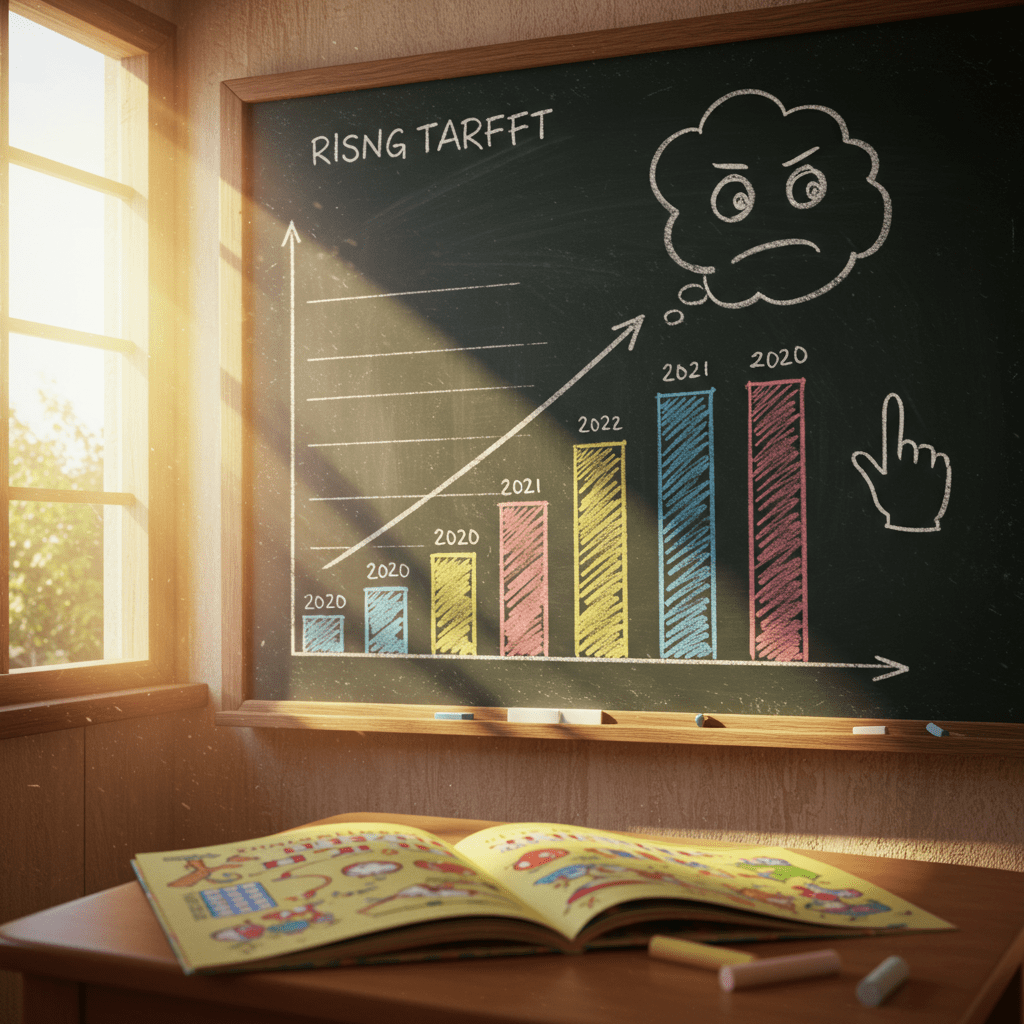Table of Contents




In the complex web of global commerce, tariffs represent a fundamental instrument of trade policy, often wielding significant influence over international trade flows and domestic industries. But what exactly are tariffs? Simply put, a tariff is a tax levied on imported goods or services, effectively increasing their price and making them less competitive relative to domestically produced alternatives. This seemingly simple mechanism can have profound economic consequences, sparking trade disputes, influencing consumer prices, and shaping the fortunes of entire industries.
This article delves into the intricacies of tariffs, providing a comprehensive understanding of their various forms, including ad valorem, specific, and compound tariffs. We will explore the underlying rationale behind their implementation, examining arguments for protectionism, revenue generation, and infant industry development. Furthermore, we will analyze the potential impact of tariffs on consumers, producers, and the broader economy, considering effects such as deadweight loss, retaliatory tariffs, and shifts in global value chains. Finally, we will discuss the role of international organizations like the World Trade Organization (WTO) in regulating tariff policies and mitigating trade conflicts. By the end of this article, you will possess a thorough grasp of this crucial element of international trade policy.
What Are Tariffs: A Deep Dive into Trade Protectionism
Tariffs are customs duties or taxes imposed on imported goods and services. They represent a form of trade protectionism implemented by governments to protect domestic industries from foreign competition, generate revenue, or address specific political or economic objectives. Understanding the intricacies of tariffs is crucial for businesses engaged in international trade, policymakers shaping economic strategies, and consumers impacted by their effects.
Types of Tariffs
Tariffs can be classified based on various criteria, including their purpose, method of calculation, and the goods they target.
1. Ad Valorem Tariffs: These are levied as a percentage of the imported good’s value. For example, a 10% ad valorem tariff on a $100 product would result in a $10 tariff. This is the most common type of tariff due to its flexibility in adjusting to fluctuating prices.
2. Specific Tariffs: These are fixed charges imposed per unit of the imported good, regardless of its value. For instance, a specific tariff of $2 per kilogram of steel would be applied to all imported steel, irrespective of its price per kilogram. This type offers predictability but can become less effective during periods of price volatility.
3. Compound Tariffs: These combine both ad valorem and specific tariffs. For example, a compound tariff might involve a 5% ad valorem duty plus a $1 per unit specific duty. This approach provides a dual mechanism for revenue generation and protection.
4. Protective Tariffs: These are specifically designed to shield domestic industries from foreign competition by making imported goods more expensive. This can lead to increased domestic production and employment but may also result in higher prices for consumers.
5. Revenue Tariffs: The primary objective of these tariffs is to generate revenue for the government. They are typically applied to goods not produced domestically or where domestic production is insufficient to meet demand. Historically, tariffs were a significant source of government revenue, but their importance has declined in modern economies.
The Impact of Tariffs on Businesses and Consumers
Tariffs have profound implications for businesses involved in international trade and for consumers who purchase imported goods.
1. Increased Prices for Consumers: Tariffs directly translate into higher prices for imported goods, reducing consumer purchasing power. For example, the US imposed tariffs on imported washing machines in 2018, leading to a price increase of approximately 12%, according to a study by the University of Chicago. This burden disproportionately affects low-income households who spend a larger portion of their income on essential goods.
2. Reduced Consumer Choice: Tariffs can limit the availability of imported goods, reducing consumer choice and potentially hindering access to innovative products and technologies. This can stifle competition and innovation in the domestic market.
3. Higher Input Costs for Businesses: Businesses relying on imported raw materials or intermediate goods face increased production costs due to tariffs. This can lead to reduced profitability, job losses, and decreased competitiveness in both domestic and international markets. For instance, tariffs on steel and aluminum imposed by the US in 2018 negatively impacted the automotive industry, which relies heavily on these materials.
4. Retaliatory Tariffs and Trade Wars: Imposing tariffs often triggers retaliatory measures from other countries, leading to trade wars where multiple countries impose tariffs on each other’s goods. This can disrupt global trade flows, harm businesses, and negatively impact economic growth. The US-China trade war that began in 2018 exemplifies this scenario, with both countries imposing tariffs on billions of dollars worth of goods.
Historical Examples and Personal Experiences
History is replete with examples of tariffs and their consequences. The Smoot-Hawley Tariff Act of 1930, which significantly raised US tariffs on imported goods, is widely believed to have exacerbated the Great Depression by reducing international trade and triggering retaliatory tariffs.
On a personal level, I recall witnessing the impact of tariffs on small businesses during my time working as a consultant for a trade association. Several small businesses importing specialized components from Europe faced significant challenges due to newly imposed tariffs. These businesses struggled to absorb the increased costs, leading to price increases, reduced sales, and in some cases, even closures. One business owner, a manufacturer of high-end bicycles, shared his frustration about the increased cost of imported components, forcing him to raise prices and lose market share to domestic competitors.
The Role of Tariffs in Trade Negotiations
Tariffs are often used as bargaining chips in trade negotiations. Governments may threaten to impose tariffs or offer to reduce them as leverage to secure concessions from other countries. This strategic use of tariffs can lead to mutually beneficial trade agreements but can also escalate into trade disputes. The World Trade Organization (WTO) plays a crucial role in regulating tariffs and resolving trade disputes among member countries. The WTO’s most-favored-nation principle requires member countries to treat all other members equally in terms of tariffs, promoting non-discrimination in international trade.
Conclusion
Tariffs are a complex instrument of trade policy with far-reaching consequences for businesses, consumers, and the global economy. While they can provide temporary protection for domestic industries and generate revenue, they often lead to higher prices, reduced consumer choice, and trade disputes. Understanding the different types of tariffs, their impact, and their role in trade negotiations is essential for navigating the complexities of international trade in today’s globalized world.
As businesses and policymakers grapple with the challenges and opportunities of international trade, a thorough understanding of tariffs remains crucial for informed decision-making. The ongoing debate surrounding the use of tariffs highlights the need for a nuanced approach that balances the interests of domestic industries with the benefits of free and open trade.
In conclusion, tariffs, as a form of protectionist trade policy, function by imposing duties on imported goods, thereby increasing their price and potentially decreasing their competitiveness within the domestic market. We have established that tariffs can be implemented for various reasons, including protecting nascent industries, safeguarding domestic employment, and generating government revenue. Specific types, such as ad valorem, specific, and compound tariffs, are levied based on the value, quantity, or a combination of both, respectively. Furthermore, understanding the impact of tariffs requires analyzing their effect on domestic producers, consumers, and the overall economy.
While potentially beneficial to domestic producers by shielding them from foreign competition, tariffs can lead to higher prices for consumers and retaliatory measures from other countries, potentially triggering trade wars. The implementation of tariffs necessitates careful consideration of the potential benefits and drawbacks, along with a thorough understanding of their impact on various stakeholders within the global trade ecosystem.
Moving forward, policymakers must engage in comprehensive cost-benefit analyses and prioritize multilateral trade agreements to foster a more predictable and stable international trading environment. Businesses should actively monitor tariff changes and adapt their supply chains accordingly to mitigate potential disruptions. Finally, consumers should remain informed about the impact of tariffs on prices and advocate for policies that promote free and fair trade.
Frequently Asked Questions
What is a tariff?
A tariff is a tax imposed by a government on goods imported from another country. It’s a form of trade protectionism designed to make imported goods more expensive, thus increasing the competitiveness of domestically produced goods. Tariffs are also a source of government revenue.
What are the different types of tariffs?
There are primarily two types: ad valorem tariffs, which are levied as a percentage of the imported good’s value, and specific tariffs, which are a fixed fee per unit of the imported good. Compound tariffs combine both ad valorem and specific components.
Who pays tariffs?
While importers initially pay the tariff to customs authorities, the cost is often passed on to consumers through higher prices. The incidence of the tariff, or who ultimately bears the burden, depends on the elasticity of supply and demand.
What is the purpose of imposing tariffs?
Governments impose tariffs for various reasons, including protecting domestic industries from foreign competition, generating revenue, retaliating against unfair trade practices by other countries, and safeguarding national security interests related to specific industries.
How do tariffs affect international trade?
Tariffs can reduce the volume of international trade by making imported goods more expensive. This can lead to trade wars, where countries retaliate with their own tariffs, ultimately harming global economic growth. They can also distort resource allocation, leading to inefficiencies in production and consumption.




